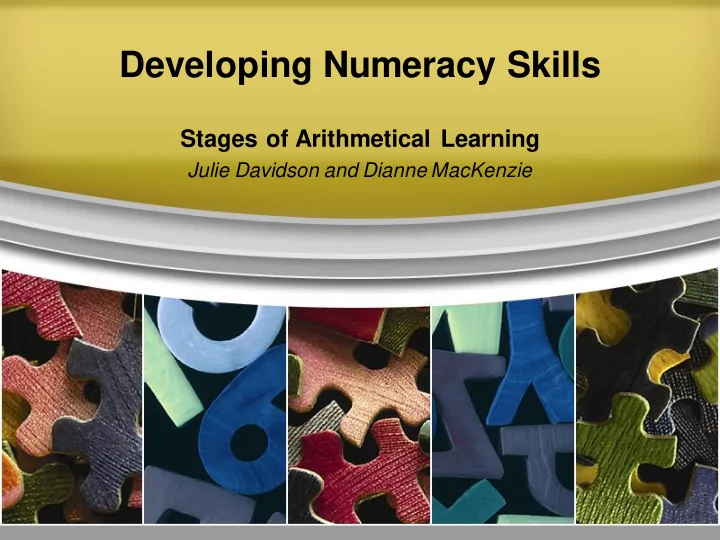

Developing Numeracy Skills Stages of Arithmetical Learning Julie Davidson and Dianne MacKenzie
Aims • Significant shifts in learning • Developing pedagogy • SEAL - more than Early Level • SEAL - not a resource • Teachers need time to develop their understanding of SEAL and consider the impact this has on Learning and Teaching
Learning and Teaching in Numeracy From the early stages onwards, children and young people should experience success in mathematics and develop the confidence to take risks, ask questions and explore alternative solutions without fear of being wrong. They will enjoy exploring and applying mathematical concepts to understand and solve problems, explaining their thinking and presenting their solutions to others in a variety of ways. Mathematics: Principles and Practice
Let’s start with the children
What does the research say? • There are significant differences in the If the research indicates this…… numerical knowledge of children when they begin school. How can we give every child a • Differences in number knowledge increase positive understanding and success as the child progresses through school in early number? • There is a clear tendency for low attainers How do we identify and support in the early years to continue to be low development needs? attainers.
Observing the learner
The Stages of Early Arithmetical Learning A model which highlights significant shifts in how children think about and understand number
A - SEAL: Stages of Early Arithmetical Learning Emergent Attempts to Count B - FNWSs: Forward Number Word Sequences Counts seen items Figurative BNWSs: Backward Number Word Sequences Forward and Number Backward Numeral Identification Structures Number Perceptual Screened / Count from 1 Word Also focus on knowledge of: Sequences Initial Number Counts on C - Structuring numbers Numeral Multiplication C - Tens and Ones = conceptual place value Identification and Division Intermediate Number Count down to/from and D - Multiplication and Division Recognition Facile Range of Non-Count by ones
Because….. “ ….there is no such thing as arithmetical ability: only arithmetical abilities. The corollary is that arithmetical development is not a single process, but several processes, involving the development of different components. “ Ann Dowker, The Development of Mathematical Skills
Signposts
Emergent Counting What do you see….. • Organisation • Numeral Sequence • 1-1 correspondence • IMBY – It might be you! Table 19 – person with longest hair Murray
Emergent Counting – What do I need? • Copying and saying short number sequences forwards and backwards • Using domino patterns and random arrays to develop ability to ascribe number • Making Spatio-motor/Auditory patterns to match spatial patterns • Making finger patterns – seen and unseen • Copying and Counting temporal patterns and temporal sequences…including double patterns CfE Early Level - MNU 0-02a I have explored numbers, understanding that they represent quantities and I can use them to count, create sequences and describe order
What does this mean for our teachers? Research indicates that the quality of instruction is an important factor influencing student achievement in mathematics…. We believe this quality of instruction is critically important and is directly tied to the teachers’ specialised knowledge of the teaching and learning of mathematics; that is, what is referred to as pedagogical content knowledge. (Shulman, 1986) Developing Number Knowledge Wright, Ellemor-Collins and Tabor
Perceptual Counting able 5 – person with the shiniest shoes T
Perceptual Counting - What do I need • Saying alternate FNWS, BNWS • Saying the number word before and after • Sequencing/Identifying numerals 1-20 • Counting two collections with one screened then two screened • Counting items in a row with some screened • Partitioning visible and flashed patterns to 10 • Combining patterns • Finger patterns ; Five plus, partitioning 3-10, Doubles plus 1, Partitioning 10 fingers • Describing equal groups, organising equal groups, making equal groups, describing equal shares, organising equal shares, partitioning equal shares
The Learning Cycle – What can SEAL offer? Initial and on-going assessment Problem solving SEAL opportunities to challenge Clear Learning current stage of Pathways development Constructivist teaching with related teaching activities Curriculum for Excellence – Cumulative Growth
Promoting discussion about strategies
What do they need? • Develop understanding of tens and ones • Opportunities to explore the structure of numbers to 100. • Combine and partition numbers in a variety of ways • Tens and ones - creating and counting • Developing jump strategies for addition and subtraction • Developing Knowledge and recall of equal shares and groups What do they NOT need? Algorithms (not yet!)
What are the key features of effective learning and teaching in numeracy? • Active learning and planned purposeful play • Development of problem solving activities • Developing mental agility • Frequently asking children to explain their thinking • Use of relevant contexts and experiences, familiar to children and young people • Using technology in appropriate and effective ways Numeracy across learning – Pg 2
Curriculum for Excellence ‘Children and young people will most effectively develop their numeracy through cumulative growth in their understanding of key concepts and the application of their skills in new contexts .’ Numeracy across learning – Page 3
Let’s finish with our teachers!
Early Numeracy: Assessment for Teaching and Intervention (Maths Recovery Series) by Mr Robert J Wright, Mr James Martland and Ann K Stafford (Paperback - 5 Jan 2006) ISBN: 978-1-4129-1020-0 Teaching Number: Advancing Children's Skills and Strategies (Maths Recovery Series) by Mr Robert J Wright, Garry Stanger, Ann K Stafford and Mr James Martland (Paperback - 13 Sep 2006) ISBN: 978-1-4129-2185-5 Teaching Number in the Classroom with 4-8 year olds (Maths Recovery Series) by Mr Robert J Wright, Garry Stanger, Ann K Stafford and Mr James Martland (Hardcover - 5 Jan 2006) ISBN: 978-1-4129-0757-6 Introducing SEAL, Mhairi Stratton, 2011
Recommend
More recommend